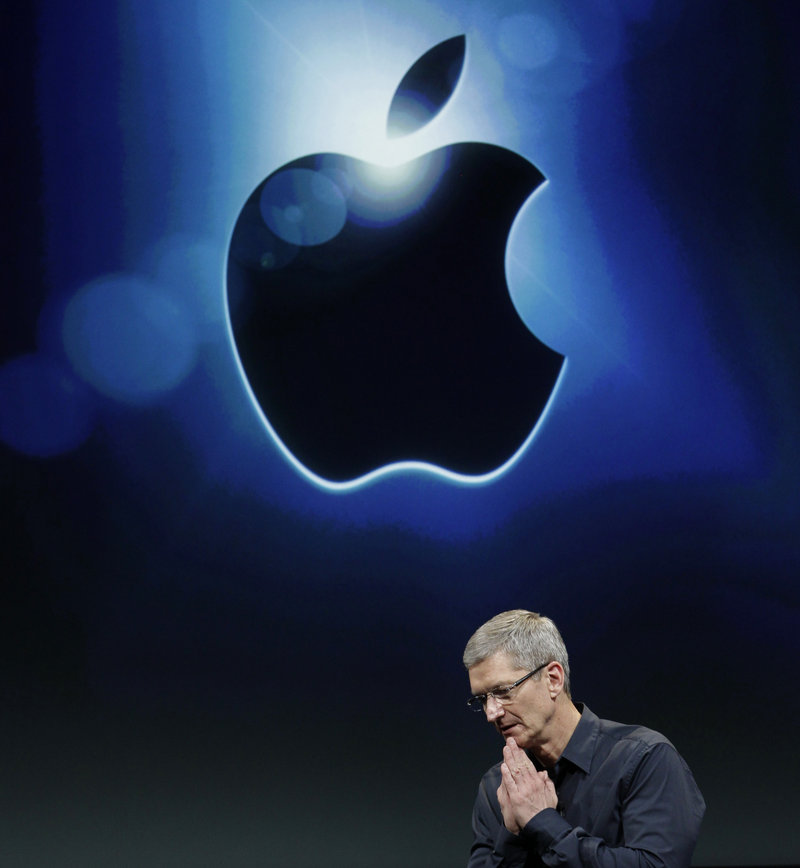NEW YORK — Apple is finally acknowledging that it has more money than it needs. But don’t expect it to cut prices on iPhones and iPads. Instead, the company said Monday that it will reward its shareholders with a dividend and a share buyback program.
Apple, the world’s most valuable company, sits on $97.6 billion in cash and securities. The decision to return some of that money to investors is a clear signal that Apple is taking a different approach in the post-Jobs era.
Former CEO Steve Jobs resisted calls to issue dividends for years. He argued that the money was better used to give Apple maneuvering room to, for instance, make strategic acquisitions. Apple did pay a quarterly dividend between 1987 and 1995, but Jobs was not involved with the company at the time.
Jobs died in October after a long fight with cancer.
On Monday, new CEO Tim Cook said that, with as much cash as Apple has on hand, a dividend won’t restrain the company’s options.
“These decisions will not close any doors for us,” he told analysts and reporters on a conference call.
Had it kept amassing cash and low-yielding securities, Apple eventually could have opened itself to a legal challenge from shareholders, who could have argued that it was misusing their money.
Apple said that it will pay a quarterly dividend of $2.65 per share, starting in its fiscal fourth quarter, which begins July 1.
The dividend works out to $10.60 annually, or 1.8 percent of the current stock price. Analyst Tavis McCourt at Morgan Keegan said the dividend is relatively generous for a large technology company. However, Microsoft Corp. pays 2.5 percent of its stock price in dividends, and Hewlett-Packard Co. pays 2 percent.
Energy and phone companies often pay dividends worth more than 5 percent of their stock price.
In absolute terms, Apple will pay one of the richest dividends in the United States. It will spend more than $10 billion on dividends in its first year, placing it just below companies including AT&T Inc. and Verizon Communications Inc., which use dividends as their main way to attract investors.
Exxon Mobil Corp., the world’s second largest company by market capitalization, pays about $9 billion in dividends annually.
Apple generated $31 billion in cash in the fiscal year that ended in September, and is on pace to generate even more in the current year. That means its cash pile will continue to grow even with a dividend and a buyback program, albeit at a lower rate.
Even if it had no net cash, Apple would hardly be financially constrained, since it could borrow all the money it needs.
The dividend opens up ownership of Apple shares to a wider range of stock mutual funds, potentially boosting the stock price in the long term. Many “value-oriented” funds are not allowed to buy stocks that don’t pay dividends.
Apple said the $10 billion share buyback program will begin next fiscal year, which starts Sept. 30, and run for three years.
Investors had been expecting the announcement, driving Apple’s stock up 37 percent since management hinted in January that a dividend was in the works.
Buybacks are a popular alternative to dividends, since they reduce the number of shares outstanding. That means every remaining investor has title to a larger share of the company.
Cook said the main point of Apple’s buyback is to offset the shares issued to reward the Cupertino, Calif., company’s employees.
In late morning trading, Apple shares rose $7.93, or 1.3 percent, to $593.50. Last week, the shares hit an all-time record of $600.01.
McCourt raised his price target on Apple’s stock to $800 on Monday, becoming the first Wall Street analyst to do so. A dozen have price targets in the $700 range. He had been expecting the dividend, he said, and the main reason for the higher price target is the company’s tremendous profit growth.
The dividend and buyback announcement comes three days after the launch of Apple’s latest iPad tablet in the United States and nine other countries. Cook said sales the first few days set a record, but gave no details.
Cook said the company also considered splitting its stock, and continues to look at that option. Stock splits increase the number of shares while reducing their value, potentially making it easier for small investors to buy them. But Cook said “there’s very little support” for the idea that this helps the stock overall.
Cook suggested that the dividend could have been larger if U.S. tax laws were different.
Cook said that as Apple analyzed how much it could give out to shareholders, it looked solely at the cash it has in the United States.
Apple is reluctant to bring back overseas profits. In addition to being taxed in their respective countries, those profits would be subject to the 35 percent U.S. corporate tax rate.
“Current tax laws provide a considerable economic disincentive to U.S. companies that might otherwise repatriate a substantial amount of foreign cash,” Chief Financial Officer Peter Oppenheimer said.
Cook suggested that the dividend could have been larger if U.S. tax laws were different.
Copy the Story LinkSend questions/comments to the editors.



Success. Please wait for the page to reload. If the page does not reload within 5 seconds, please refresh the page.
Enter your email and password to access comments.
Hi, to comment on stories you must . This profile is in addition to your subscription and website login.
Already have a commenting profile? .
Invalid username/password.
Please check your email to confirm and complete your registration.
Only subscribers are eligible to post comments. Please subscribe or login first for digital access. Here’s why.
Use the form below to reset your password. When you've submitted your account email, we will send an email with a reset code.